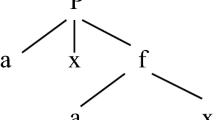Abstract
The constant-abstraction and variable-abstraction methods for associative-commutative unification were proposed by Herold, Livesey, and Siekmann and by Stickel, respectively. These methods are compared here for efficiency and conceptual purity. The pure variable-abstraction method is easier to implement but less efficient for the variables and constants case than the constant-abstraction method. With obvious refinements, the former method can be made comparably efficient and similar in behavior to the latter. The refined method uses solutions of homogeneous linear Diophantine equations under additional constraints, instead of the conceptually simpler homogeneous or inhomogeneous linear Diophantine equations without additional constraints of the pure variable-abstraction method or the constant-abstraction method.
Similar content being viewed by others
References
Guckenbiehl, T. and Herold, A. ‘Solving linear Diophantine equations.’ Fachbereich Informatik, Universität Kaiserslautern, Kaiserslautern, West Germany (1985).
Herold, A. ‘Combination of unification algorithms.’ Proceedings of the 8th International Conference on Automated Deduction, Oxford, England (July 1986).
Herold, A. and Siekman, J. ‘Unification in Abelian semigroups.’ Journal of Automated Reasoning 3 (3), 247–283 (1987) (this issue).
Huet, G. ‘An algorithm to generate the basis of solutions to homogeneous linear Diophantine equations.’ Information Processing Letters 7, 3, 144–147 (April 1978).
Livesey, M. and Siekmann, J. ‘Unification of A+C terms (bags) and A+C+I terms (sets).’ Interner Bericht Nr. 5/76, Institut für Informatik I, Universität Karlsruhe, Karlsruhe, West Germany (1976).
Stickel, M. E. ‘A complete unification algorithm for associative-commutative functions.’ Proceedings of the Fourth International Joint Conference on Artificial Intelligence, Tbilisi, U.S.S.R., 71–76 (September 1975).
Stickel, M. E. ‘A unification algorithm for associative-commutative functions.’ Journal of the Association for Computing Machinery 28 (3), 423–434 (July 1981).
Stickel, M. E. ‘A case study of theorem proving by the Knuth-Bendix method: discovering that x 3=x implies ring commutativity.’ Proceedings of the 7th International Conference on Automated Deduction, Napa, California, 248–258 (May 1984).
Yelick, K. ‘Combining unification algorithms for confined regular equational theories.’ Proceedings of the First International Conference on Rewriting Techniques and Applications. Dijon, France, May 1985, Lecture Notes in Computer Science202, Springer-Verlag, Berlin, West Germany, pp. 365–380.
Author information
Authors and Affiliations
Additional information
This paper resulted from a visit to the University of Kaiserslautern, during which discussions with Alexander Herold and Jörg Siekmann enabled each of us to gain a greater understanding and appreciation of one another's algorithms. The visit was partially supported by the Deutsche Forschungsgemeinschaft, Sonderforschungsbereich 314, “Künstliche Intelligenz-Wissensbasierte Systeme”. Preparation of this paper was supported, in part, by the Defense Advanced Research Projects Agency under Contract N00039-84-K-0078 with the Space and Naval Warfare Systems Command. The views and conclusions contained herein are those of the author and should not be interpreted as representative of the official policies, either expressed or implied, of the Defense Advanced Research Projects Agency or the United States government. Approved for public release. Distribution unlimited.
Rights and permissions
About this article
Cite this article
Stickel, M.E. A comparison of the variable-abstraction and constant-abstraction methods for associative-commutative unification. J Autom Reasoning 3, 285–289 (1987). https://doi.org/10.1007/BF00243792
Received:
Issue Date:
DOI: https://doi.org/10.1007/BF00243792




